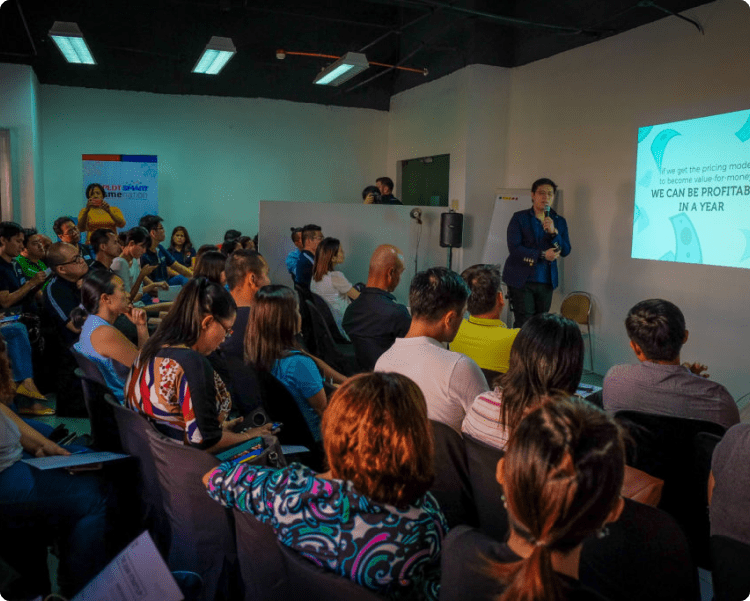The lost productivity of actively disengaged employees costs the US economy $370 BILLION annually. (Gallup)
-min.png)
Employees who are not engaged can negatively affect a business in numerous areas such as teamwork, quality control, absenteeism, innovation, customer relations, and overall team morale. The worse thing is, by affecting morale negatively, there is a high chance that they will cause more engaged employees to leave and seek a more favorable working environment elsewhere.
As millenials continue to take over the workforce (they are estimated to take over 75% of the workforce by 2030), companies are rethinking the way they engage their people. Millenials have a very different perspective of work and are generally harder to engage.
Sean’s workshop on ‘The Truth About Employee Engagement’ deals with making sure that your employees become more engaged with the work they do. Studies in the U.S. show that increasing employee engagement even in the slightest way can result in:
37% lower absenteeism
25% lower turnover (in high-turnover organizations)
65% lower turnover (in low-turnover organizations)
28% less shrinkage
48% fewer safety incidents
41% fewer patient safety incidents
41% fewer quality incidents (defects)
10% higher customer metrics
21% higher productivity
22% higher profitability
-min.png)
For managers and team leaders who genuinely desire to engage their people with the work they do.
This workshop can accommodate 10 – 35 people only.
People who will attend, learn and practice the workshop will experience engaged employees who:
Find fulfillment, enthusiasm and passion in their work
Show more attention to detail
Develop a sense of ownership and pride in their work
Pitch-in in areas outside of their own responsibility
Stay within the organization; thereby, reducing turnover
Help attract other quality employees

People cannot be fulfilled in their work if they are not known. All human beings need to be understood and appreciated for their unique qualities by someone in a position of authority.
Everyone needs to know that their job matters, to someone. Anyone. Without seeing a connection between the work and the satisfaction of another person or group of people, an employee simply will not find lasting fulfillment.
Employees need to be able to gauge their progress and level of contribution for themselves. They cannot be fulfilled in their work if their success depends on the opinions or whims of another person.
Numerous companies have taken on Sean’s services in workshops in business development, entrepreneurship, and startups and he has produced returns of over a thousandfold.















If you want me to do The Truth About Employee Engagement Workshop for your organization, here’s how the process goes:
We set a meeting about who you are, what you do, how you do it and why. This is so I become familiar on how to package the Workshop for you and your participants.
We establish where you want to be. You are on point A, where is point B? How can The Lean Startup Workshop take you there?
I customize The Lean Startup Workshop to suit your needs.
We agree on a rate (I’m paid per hour but the rate depends on the scope and difficulty of work)
I personally facilitate The Lean Startup Workshop and see it to completion.
Sit back, relax, see your organization change and grow to be more innovative and launch products and services successfully.
Here, you'll find more statistics and insights about employee engagement. It's a deeper look into what motivates and drives your workforce.

The lost productivity of actively disengaged employees costs the US economy $370 BILLION annually. (Gallup)
In February, June, and October of 2010, the number of employees voluntarily quitting surpassed the number fired or discharged. (US Bureau of Labor Statistics)
70% of engaged employees indicate they have a good understanding of how to meet customer needs; only 17% of non-engaged employees say the same. (Wright Management)
78% would recommend their company’s products of services, against 13% of the disengaged. (Gallup)
Engaged employees advocate their company or organization – 67% against only 3% of the disengaged. (Gallup)
From a global sample of 60 corporations the Corporate Leadership Council found that over 80% of senior human resources (HR) professionals agreed that employee engagement was a high priority for 2009 and 40% claimed it had become more of a priority over the last year. Senior private sector HR managers believe that the top challenge they face now is maintaining employee engagement.
86% of engaged employees say they very often feel happy at work, as against 11% of the disengaged. 45% of the engaged say they get a great deal of their life happiness from work, against 8% of the disengaged. (Gallup)
Less than 50% of chief financial officers appear to understand the return on their investments in human capital. (Accenture)
75% of leaders have no engagement plan or strategy even though 90% say engagement impacts on business success. (ACCOR)

Higher levels of engagement are strongly related to higher levels of innovation. 59% of engaged employees say that their job brings out their most creative ideas against only 3% of disengaged employees. (Gallup)
Based on survey findings from approximately 1,500 managers throughout the UK, where respondents identified the prevailing management style of their organization as innovative, 92% of managers felt proud to work there.
From 2008 – 2009 the numbers saying their manager supported new ways of doing things declined from 51% to 40 per cent; the numbers reporting that managers were encouraging them to develop their own ideas declined from 51% to 43%; and those reporting their manager encouraged them to try new ideas out declined from 48% to 38%. (CLC Research)
Only 29% of UK employees believed their senior managers were sincerely interested in their well‐being; only 31% thought their senior managers communicated openly and honestly; only 3% thought their managers treated them as key parts of the organization and no fewer than 60% felt their senior managers treated them as just another organizational asset to be managed. (Towers Watson)
Only 51% of staff felt they were involved or consulted on decisions that might affect their work area, team or department; only 27% thought senior managers involved staff in important decisions. (NHS Survey)
Only 40% of employees are satisfied with relations between managers and employees in their organization. (Kingston Business School)
39% of employees feel senior management does not exhibit attitudes and behaviors that reflect they care about the wellbeing of their employees. (Towers Watson)
75% of people voluntarily leaving jobs don’t quit their jobs; they quit their bosses. (Roger Herman)

Out of 10,914 workers surveyed by Blessing White, only 31% are engaged
Fewer than 1 in 3 employees worldwide (31%) are engaged. Nearly 1 in 5 (17%) are actually disengaged. Engagement levels vary by region from 37% in India to 17% in China.
Despite the economic recession, more employees are looking for opportunities outside of their organization than they were in 2008, suggesting that 2011 will be a challenging year for retention (and a hot market for firms to attract top talent).
Trust in executives can have more than twice the impact on engagement levels than trust in immediate managers does.
Employees worldwide who know their managers as “people” are more likely to be engaged.
The higher up in the organization you go, the more likely you are to be engaged.
Engagement levels are higher among older employees and people in positions of power and authority.
Engagement increases with organizational tenure.
Engagement surveys without visible follow-up action may decrease engagement levels, suggesting that organizations think twice before flipping the switch on measurement without 100% commitment for action planning based on the results.
-min.png)
Worker satisfaction. Research conducted by Time magazine in 2010 indicated that less than half of American workers (45%) are satisfied with their jobs. This is the lowest percentage since 1987 and is an indication that U.S. employers have a lot of work ahead of them to undo the effects of the economic downturn and deteriorating employee attitudes.
Turnover. According to a Gallup poll, companies with large numbers of dissatisfied workers experience greater absenteeism and lower productivity. The most telling figure was the amount of turnover these employers experience which was 51% higher than their peers. Effective engagement strategies should target on-the-job satisfaction as a way to reduce turnover and maintain smooth workflows.
Job security. More than half of U.S. workers feel their jobs are less secure now than they were a year ago. Approximately 70% of workers who feel their jobs are secure report happiness at work, but half of the workers who feel their jobs are in jeopardy are dissatisfied with their jobs. The takeaway from these statistics is that job security and employee satisfaction are connected, even though many workers are only hanging onto their jobs for a paycheck.
-min.png)
72% of US workers are not engaged in their work. Defined as essentially sleep walking throughout their day. (Gallup)
1 in 4 workers intend to jump ship within a year. (Telework Research Network)
18% of dis-engaged employees actually undermine their co-workers’ success. (Gallup)
Source: “What makes a happy vs. sad (disengaged) worker”, Citrix
-min.png)
Higher employee engagement resulted in a 50% reduction in reportable accidents from 18% to 9% over a two year period. (Babcock Marine Clyde)
More than 66% of those managers who reported that they were motivated at work also claimed high productivity levels (defined as more than 90%). Only 15% who were motivated experienced low levels of productivity (defined as less than 70%). (CMI)
Those companies with a highly engaged workforce improved operating income by 19.2% over a period of 12 months, whilst those companies with low engagement scores saw operating income decline by 32.7% over the same period. (Towers Watson)
Engaged employees in the UK take an average of 2.69 sick days per year; the disengaged take 6.19. (Gallup)

Engagement and involvement are critical in managing change at work; nine out of ten of the key barriers to the success of change programs are people related. (PWC)
Only 24% of private sector employees believe change is well managed in their organizations (15% in the public sector). (Ipsos MORI)

Retirement worries loom large. Only 43 percent of employees say they’re doing enough to prepare for retirement. That’s down from 47 percent in 2005.
Benefits programs don’t get the raves they once did. Some 68 percent of employees.
Health care in particular is seen as less generous. Only 59 percent are satisfied with their health benefits, down from 66 percent.
Pay isn’t great either. Just 53 percent are satisfied with their base pay, down from 58 percent in 2005.
Source: Half of Workers Just Don’t Care

69% of employees would work harder if they were better recognized
78% of U.S. workers said being recognized motivates them in their job
49% of employees said they would leave their current job for a company that clearly recognized employees for their efforts and contributions
Among respondents who stated they plan to search for a new job this year, only 24% are satisfied with the level of recognition they receive at work. Conversely, 63% of employees who have no plans of leaving are satisfied with their level of recognition.
An overwhelming majority (84 percent) of all 630 respondents preferred a wide choice of gift cards as the primary reward mechanism.
65 percent of employees satisfied in their roles said they would also work harder if they were better recognized at work.
78 percent said being recognized motivates them in their job
Source: Workforce Mood Tracker survey (630 global corporate respondents)

Companies with high levels of employee engagement improved 19.2% in operating income while companies with low levels of employee engagement declined 32.7% (Towers Watson)
If organizations increased investment in a range of good workplace practices which relate to engagement by just 10%, they would increase profits by $2,400 per employee per year. (IES/Work Foundation Report)
Increased employee engagement was accompanied by a 12% increase in customer satisfaction and significant double-digit revenue and margin growth over the past three years. (Serco Study)
Engaged organizations grew profits as much as three times faster than their competitors. They report that highly engaged organizations have the potential to reduce staff turnover by 87% and improve performance by 20%. (Corporate Leadership Council)
A 1% increase in employee commitment can lead to a monthly increase of 9% in sales. (IES)

24% of team members say they don’t see their managers enough
58% of team are worried about their benefits
84% of managers don’t know how to accurately measure their team members
32% of team doesn’t know their next move in the company
32% of adult US workers listen to music at work on an MP3 player or similar device; 79% say it improves their job satisfaction and/or productivity
46% of new hires leave their jobs within the first year.
56% of women feel that at one time or another they have been disadvantaged in the workplace because of their gender
Your email address will not be published. Required fields are marked *
